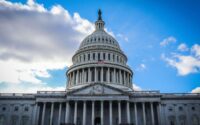Fixing The Debt Ceiling Crisis… Via Gold
Submitted by Paul H. Kupiec and Alex J. Pollock,
When it comes to the debt ceiling, both the Fed and the New York Times get It wrong…

At the February FOMC press conference, Federal Reserve Chairman Powell was asked, “…about the debt ceiling. Given that we’ve now hit up against it…will the Fed do what Treasury directs as it relates to making payments or will it do its own analysis of any legal constraints?” Powell responded, “There’s only one way forward here, and that is for Congress to raise the debt ceiling.”
But those are not the only choices.
There is a better way forward that is legally sound and has nothing to do with creating a fictitiously-valued platinum coin.
Congress should simply direct the US Treasury to value its gold holdings, which are real, at real market prices.
The Treasury would then have sufficient funds to pay its bills beyond fiscal 2023 without raising the debt limit.
The current market price of gold is a little over $1,875 per ounce. Treasury owns about 261.5 million ounces of gold, or more than eight tons. Because the Gold Reserve Act, as amended by Congress in 1973, requires the US Treasury to value its gold at $42.22 on ounce, the Treasury values its gold holdings at a little over $11 billion whereas the true market value of its gold is roughly $490 billion.
If Congress were to make a simple, financially sound amendment to the Gold Reserve Act, it would free up nearly $480 billion in new Treasury cash without raising the debt limit.
These funds would allow the Treasury to pay all its bills past the end of fiscal 2023, thereby giving Congress an entire session to debate, negotiate budgets, reduce deficits, and set the debt ceiling accordingly, all in bills passed under regular order—something that has not happened in years.
The US Treasury is already unquestionably authorized to monetize the value of its gold holdings by issuing gold certificates.
The Gold Reserve Act provides that: “The Secretary [of the Treasury] may issue gold certificates against other gold held in the Treasury. The Secretary may prescribe the form and denominations of the certificates.”
The US Treasury long ago used this power to create gold certificates using the now long out of date price of $42.22 per ounce to create a little more than $11 billion in gold certificates. There certificates have been on deposit at the Federal Reserve for decades. When they were originally deposited, the Fed credited the US Treasury’s account with an equivalent value of dollar balances that the Treasury could spend.
The government can fund itself past the end of the fiscal year if Congress merely recognizes that the Treasury’s gold is a real massively undervalued monetary asset. Unlike the phony idea of the Treasury issuing a trillion-dollar platinum coin, the Treasury already has the legal authority to monetize its gold holdings without creating new government debt. It is only because Congress has failed to amend a woefully outdated law that the Treasury values its gold at an absurdly low price.
To monetize the market value of the Treasury’s gold holding, the Congress need only replace five words in the Gold Reserve Act. Replacing “42 and two-ninths dollars” with “the current market value (as determined by the Secretary at the time of issuance),” would allow the Treasury to use nearly $480 billion in spendable dollars without raising the current debt limit.
With the proposed change, the Treasury can issue new gold certificates against the market value of its gold and deposit these certificates into its account with the Federal Reserve. The Fed will credit the Treasury’s account with an equivalent value in dollars, and the Treasury can spend the money as needed. In other words, Congress can create another $480 billion in spendable dollars without adding a penny of additional Treasury debt. Should the Fed deem it necessary to offset any inflation concerns, the increase in reserve balances can be sterilized with open market operations.
By simply recognizing reality, this change would give the Congress time to negotiate, in regular order, a bipartisan 2024 fiscal year budget with spending cuts, and pass a new appropriately-sized debt ceiling for government funding in fiscal 2024 and beyond.
It would be ridiculous, wouldn’t it, for the Treasury to default on its debt when it owns almost half a trillion dollars worth of the most classic monetary asset there is. By monetizing the Treasury’s gold using already existing legal processes, the government can pay its bills through the end of fiscal year 2023—with no increase in the debt limit needed and no phony platinum coin involved.
* * *
Paul H. Kupiec is a senior fellow at the American Enterprise Institute. Alex J. Pollock is a senior fellow at the Mises Institute and the co-author of the new book, Surprised Again!—The Covid Crisis and the New Market Bubble.
Loading…
[ad_2]
Source link


